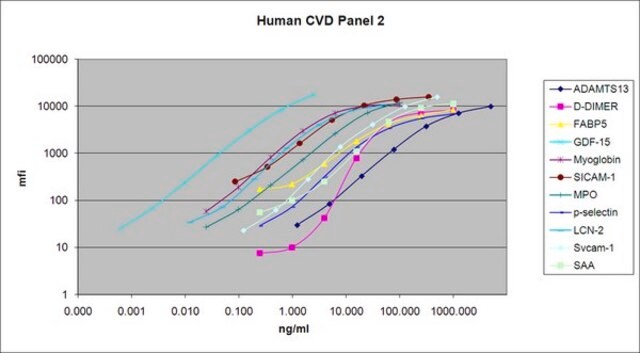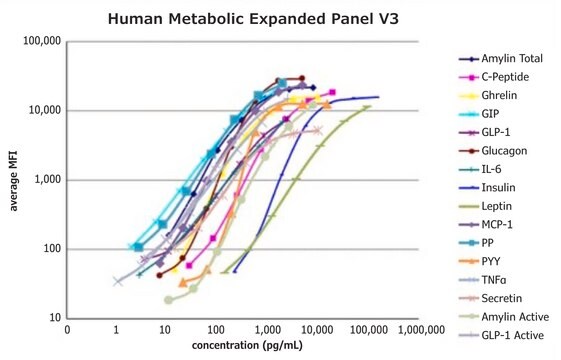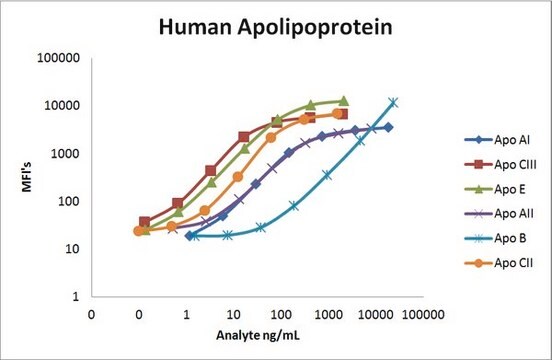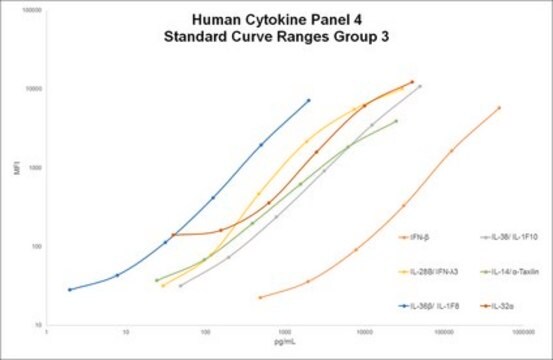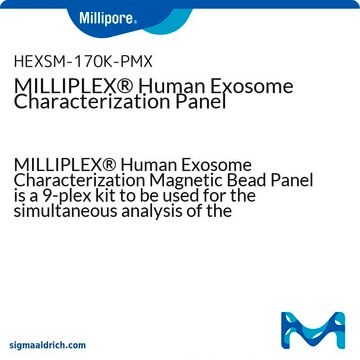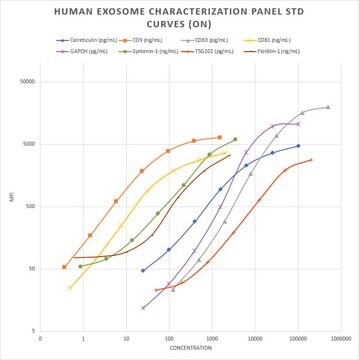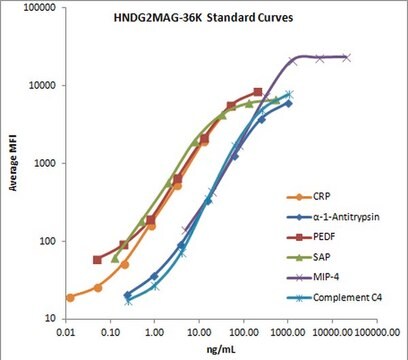HCVD3MAG-67K
MILLIPLEX® Human Cardiovascular Disease (Acute Phase) Magnetic Bead Panel 3 - Cardiovascular Disease Multiplex Assay
The analytes available for this multiplex kit are: Adipsin, AGP, α2-Macroglobulin, CRP, Fetuin A, Fibrinogen, L-Selectin, Serum Amyloid P, Haptoglobin, & Platelet Factor-4.
Synonyme(s) :
human CVD APP immunoassay panel, luminex human cardiovascular disease acute phase proteins multiplex assay, millipore human CVD acute phase proteins multiplex kit
About This Item
Produits recommandés
Niveau de qualité
Espèces réactives
human
Fabricant/nom de marque
Milliplex®
assay range
accuracy: 102%
(Haptoglobin)
accuracy: 109%
(AGP)
accuracy: 113%
(Platelet Factor-4)
accuracy: 117%
(Adipsin)
standard curve range: 0.004-15 ng/mL
(L-Selectin & SAP)
standard curve range: 0.012-50 ng/mL
(CRP)
standard curve range: 0.037-150 ng/mL
(PF4)
standard curve range: 0.061-250 ng/mL
(HPTGN)
standard curve range: 0.098-400 ng/mL
(AGP & Adipsin)
standard curve range: 0.244-1,000 ng/mL
(Fetuin A & vWF)
standard curve range: 0.488-2,000 ng/mL
(A2M)
Technique(s)
multiplexing: suitable
Méthode de détection
fluorometric (Luminex xMAP)
Conditions d'expédition
wet ice
Description générale
MILLIPLEX® Human Cardiovascular Disease (CVD) Panel 3 (Acute Phase) is a 10-plex kit to be used for the simultaneous quantification of any or all of the following analytes in human serum, plasma or tissue/cell lysate and culture supernatant samples: Adipsin, α-1-Acid-Glycoprotein (AGP), α-2-Macroglobulin (A2M), C Reactive Protein (CRP), Fetuin A, Fibrinogen, L-Selectin, Serum Amyloid P (SAP), Haptoglobin, and Platelet Factor-4 (PF4). (Please note: Fibrinogen is not detectable in serum.) This kit uses a 96-well format, contains a lyophilized standard cocktail, two internal assay quality controls and can measure up to 38 samples in duplicate.
The Luminex® xMAP® platform uses a magnetic bead immunoassay format for ideal speed and sensitivity to quantitate multiple analytes simultaneously, dramatically improving productivity while conserving valuable sample volume.
Panel Type: Cardiovascular
Application
- Analytes: α-1 Acid Glycoprotein (AGP), α-2-Macroglobulin (A2M), Adipsin (Factor D), C Reactive Protein (CRP), Fetuin A, Fibrinogen, Haptoglobin, sL-Selectin, Platelet Factor-4 (PF4/CXCL4), Serum Amyloid P (SAP)
- Recommended Sample Type: Human serum, plasma, cell/tissue culture supernatants and lysates
- Recommended Sample Dilution: 25 μL per well of 1:40,000 diluted serum or plasma; tissue/cell culture samples may require dilution in appropriate control medium
- NOTE: Fibrinogen is not detectable in serum
- Assay Run Time: Overnight (16-18 hours) at 2-8°C or 2 hours at room temperature (20-25 °C)
- Research Category: Cardiovascular Disease
- Research Subcategory: Metabolic Disorders
Caractéristiques et avantages
Autres remarques
Informations légales
Mention d'avertissement
Danger
Mentions de danger
Classification des risques
Acute Tox. 3 Dermal - Acute Tox. 4 Inhalation - Acute Tox. 4 Oral - Aquatic Chronic 2 - Eye Irrit. 2 - Skin Irrit. 2 - Skin Sens. 1 - STOT SE 3
Organes cibles
Respiratory system
Code de la classe de stockage
6.1C - Combustible acute toxic Cat.3 / toxic compounds or compounds which causing chronic effects
Certificats d'analyse (COA)
Recherchez un Certificats d'analyse (COA) en saisissant le numéro de lot du produit. Les numéros de lot figurent sur l'étiquette du produit après les mots "Lot" ou "Batch".
Déjà en possession de ce produit ?
Retrouvez la documentation relative aux produits que vous avez récemment achetés dans la Bibliothèque de documents.
Notre équipe de scientifiques dispose d'une expérience dans tous les secteurs de la recherche, notamment en sciences de la vie, science des matériaux, synthèse chimique, chromatographie, analyse et dans de nombreux autres domaines..
Contacter notre Service technique